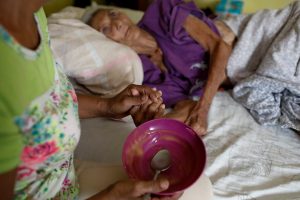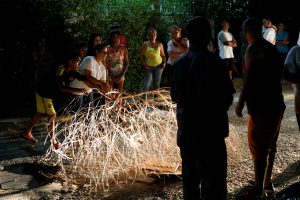
By Patrick Rucker
FAIR BLUFF, N.C. (Reuters) – When Hurricane Matthew submerged the small town of Fair Bluff, North Carolina, two years ago, Eve Waddell thought she had witnessed a once-in-a-lifetime disaster.
“You’ll never see that again,” she reassured her daughter Ella, then 4, after floodwaters surged over the banks of the Lumber River, inundating Fair Bluff with several feet of water and damaging her house.
As Hurricane Florence barreled toward the state on Wednesday, Waddell packed up her family to seek shelter with relatives and said she was ready to leave town for good – just as many businesses and hundreds of residents did after Matthew in 2016.
“This old town’s had it,” said her husband, Anthony Spivey, the police chief in a nearby municipality.
Meteorologists warn the menacing storm could stall out over the Carolinas, dumping enormous amounts of rainfall and creating massive flooding.
That was the case with Matthew, a less powerful hurricane that did most of its damage inland, producing catastrophic levels of flooding throughout low-lying eastern North Carolina and causing billions of dollars in damages.
Rural, low-income communities like Fair Bluff – already beset by economic difficulties – were hardest hit and remain most at risk this week.
Approximately 125 miles (200 km) south of Raleigh, Fair Bluff is 38 percent white and 60 percent African-American, with a median household income of $17,000, according to state figures.
Its downtown district has been a virtual ghost town since Matthew, with a dozen empty storefronts still bearing the marks of the storm’s fury.
A grimy scar cuts across retail windows, marking the height of the flooding. In a furniture shop, neatly arranged bedroom sets moldered; an abandoned hardware store was still stocked with ovens, washing machines and refrigerators.
Before the storm, Fair Bluff had nearly 1,000 residents, said Al Leonard, the town’s part-time administrator. He estimated more than a quarter left and have not returned since Matthew.
“We base our calendar on B.C. or A.D.,” Leonard said. “In Fair Bluff, they base their calendar on Before Matthew and After Matthew. Matthew changed everything.”
RURAL DEVASTATION
Other rural communities around the state’s eastern half tell a similar story.
Lumberton, a larger nearby town of approximately 21,000 people along the Lumber River, saw nearly 900 homes severely damaged by Matthew, including hundreds of low-income renters who lost their residences, according to a state report.
In Princeville, known as the oldest community settled by freed slaves in the United States, hundreds of homes were severely damaged by flooding from the Tar River.
The agricultural community of Goldsboro, along the Neuse River, saw hundreds of homes and substantial livestock destroyed.
Many low-income communities were already buffeted by a decline in manufacturing and agriculture, as well as the aftermath of the 2007-09 recession, according to Barry Ryan, vice president of the nonprofit NC Rural Center, which helps support rural counties.
“These communities are aging rapidly,” he said. “There’s been a general market downturn – somewhat driven by population loss, somewhat driven by economic restructuring.”
Jeff Axelberg, a member of Fair Bluff’s Chamber of Commerce who markets sweet potatoes, said the farmers he works with are worried because Florence is arriving so early in the season, with only about 10 percent of the crop in.
“They’re working day and night to get what they can out of the ground,” he said.
Long-term solutions are elusive. Some in town have suggested recruiting a canoe operator or other tourist draw to Fair Bluff, turning the river from a liability into an opportunity, Axelberg said.
Residents and business owners have often found it challenging to navigate state and federal bureaucracies in search of recovery and repair funds.
In many communities, homeowners are only now starting to receive money through the state’s hazard mitigation grant program to sell, elevate or rebuild their homes.
The smallest towns are also hamstrung by a lack of administrative capacity. Leonard, Fair Bluff’s administrator, also serves as the town’s water system supervisor, town planner and budget director.
He spends one day per week in Fair Bluff because he also holds the position of town administrator for four other nearby municipalities.
On Wednesday, he watched as laborers laid brick for a police office extension off the back of Fair Bluff’s town hall, which officials moved to just outside the flood zone after Matthew.
“Last time, this was high ground,” Leonard said. “We’ll just have to wait and see.”
(Reporting by Patrick Rucker in Fair Bluff, North Carolina; Additional reporting and writing by Joseph Ax in New York; Editing by Colleen Jenkins and Lisa Shumaker)



